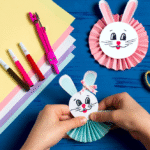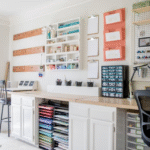In today’s fast-moving, screen-filled world, it can be challenging to find quality time with your kids that’s both fun and meaningful. That’s where paper crafts come in. They’re simple, affordable, and perfect for all ages. With just a few materials, you and your child can create colorful memories—and some beautiful artwork too.
Whether it’s a rainy day, a weekend break, or just a fun bonding session, paper crafts offer a wonderful way for parents and children to connect, learn, and laugh together.
Why Paper Crafts Are Perfect for Family Fun
Here’s why parents and kids love paper crafts:
Affordable: You only need paper, scissors, glue, and maybe crayons or markers
No fancy tools required: Anyone can do them at home with household supplies
Educational: Kids improve motor skills, hand-eye coordination, and creativity
Bonding activity: Crafting side-by-side builds stronger parent-child relationships
Mess-free (mostly): Compared to paint or clay, paper crafts are low-mess
Tips Before You Start
To make crafting smooth and stress-free, keep these things in mind:
Choose a comfortable spot with good lighting
Use child-safe scissors for younger kids
Lay down an old newspaper or mat to keep your table clean
Keep a trash bin or bag nearby for paper scraps
Let go of perfection—focus on the process, not the outcome
Easy Paper Crafts to Try Together
Here are some fun and simple paper crafts you can do at home with kids. Most of these take under 30 minutes and are great for kids aged 4 to 10.
1. Paper Plate Animals
Materials Needed:
Paper plates
Colored paper
Glue
Markers or crayons
Scissors
How to Do It:
Pick an animal like a lion, cat, or elephant. Use colored paper to make ears, eyes, nose, and other features. Glue them onto the paper plate, and decorate with crayons or markers.
Why it’s great:
It’s creative and educational. You can even turn it into a mini animal facts lesson.
2. Paper Handprint Flowers
Materials Needed:
Colored paper
Pencil
Scissors
Glue
Straws or green paper strips (for stems)
How to Do It:
Trace your child’s hand on colorful paper and cut out the shape. Make several handprints and glue them together in a flower shape. Use straws or paper for stems and add leaves.
Why it’s great:
Each flower is unique and personal—plus, you’re capturing your child’s handprint in time.
3. Origami Animals (Beginner Level)
Materials Needed:
Origami or square paper
Markers
How to Do It:
Try simple origami like paper dogs, cats, or frogs. YouTube and free printables make it easy for kids to follow along.
Why it’s great:
It builds fine motor skills, concentration, and patience. Plus, it’s fun.
4. Accordion Paper Caterpillars
Materials Needed:
Colored paper
Glue
Googly eyes or markers
Scissors
How to Do It:
Cut paper into strips and fold them back and forth like an accordion. Glue one strip to another to create a longer caterpillar. Add eyes and antennae.
Why it’s great:
It teaches folding techniques and pattern making. Kids love naming their silly caterpillars too.
5. Paper Chain Garlands
Materials Needed:
Colored paper
Glue stick or tape
Scissors
How to Do It:
Cut paper into strips and link them together in a chain. Use the chain to decorate a playroom or wall.
Why it’s great:
It’s repetitive, relaxing, and can be used to mark special events, birthdays, or holidays.
6. DIY Greeting Cards
Materials Needed:
Plain cardstock or thick paper
Markers
Stickers, washi tape, or stamps
Glue
How to Do It:
Fold the paper into a card. Let kids draw a picture or message inside. Decorate with stickers, cutouts, or stamps.
Why it’s great:
Encourages writing and emotional expression. You can also use the cards for birthdays or “just because” notes.
7. Paper Crowns
Materials Needed:
Construction paper
Scissors
Glue or tape
Decorations (glitter, buttons, foil)
How to Do It:
Cut a long strip for the crown base and decorate it however you like. Fit it to the child’s head and tape it closed.
Why it’s great:
Let your child become a king, queen, or superhero for a day—great for role play and storytelling.
Bonus Craft: Story Wheel
Create a paper wheel divided into 4–6 sections. Each slice represents part of a story (beginning, middle, end). Kids draw each part of a story and spin the wheel to tell it aloud.
It’s a fun and interactive craft that builds creativity, storytelling, and confidence.
How to Make Craft Time Special
Here are a few simple ideas to make the moment even more memorable:
Play calm background music
Give praise and encouragement, not instructions
Take pictures of your creations and make a craft photo album
Involve older siblings as little helpers or mini craft teachers
Make it a weekly ritual—“Family Craft Fridays” or “Sunday Art Hour”
Final Thoughts
Paper crafts are more than just a fun way to pass the time. They’re opportunities to bond, learn, and grow together. You don’t need expensive kits or professional art skills. All it takes is some paper, creativity, and a willingness to have fun.
So next time you’re looking for a screen-free family activity, grab some paper and get crafting. The memories you make will last far longer than any paper animal or origami flower.
Frequently Asked Questions (FAQs)
1. What age is appropriate to start paper crafting with kids?
Children as young as 3 or 4 can start simple crafts like folding paper, gluing shapes, or coloring with supervision.
2. What type of paper is best for kids’ crafts?
Construction paper is ideal because it’s colorful, sturdy, and easy to cut. For origami, use thin square paper.
3. How can I store paper craft supplies at home?
Use plastic bins, folders, or old shoeboxes to organize paper, glue, scissors, and decorations. Label them for easy access.
4. What if my child loses interest halfway through?
That’s okay. Let them take breaks or try another project later. The goal is to make crafting feel fun, not forced.
5. Can paper crafts be educational?
Absolutely. They teach fine motor skills, colors, shapes, creativity, patience, and even storytelling.







